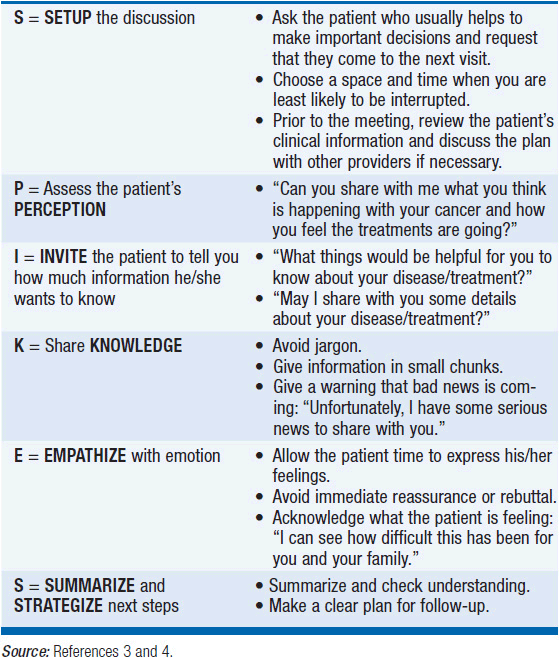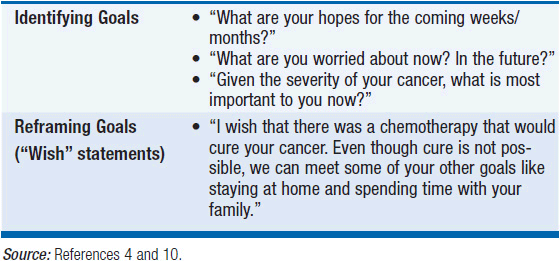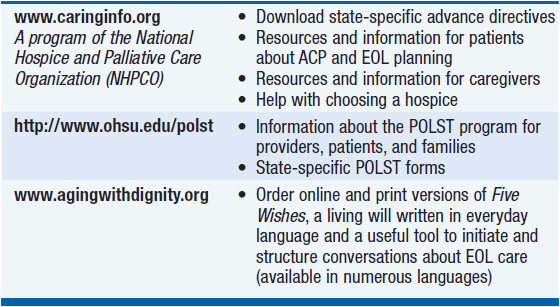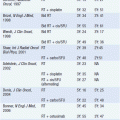Comprehensive End-of-Life Care
INTRODUCTION
Comprehensive end-of-life (EOL) care is an essential component of oncology. While we aim to cure as many patients as possible, many of them ultimately die of their disease. Our role as clinicians includes guiding patients and their families through the EOL. Comprehensive EOL care encompasses pain and symptom management, psychosocial and spiritual support, care-giver/family support, and discussions about goals of care and advance care planning. This requires skills in communication and symptom management, as well as knowledge of the services available in the community. A multidisciplinary approach is often helpful in providing comprehensive EOL care, and the team may include physicians, nurses, social workers, chaplains, palliative care, and/or hospice.
END-OF-LIFE CARE COMMUNICATION
 APPROACH TO DIFFICULT CONVERSATIONS
APPROACH TO DIFFICULT CONVERSATIONS
Patients and families consider communication to be one of the most important aspects of EOL care (1). Discussions about goals of care, treatment preferences, and advance care planning can be difficult for clinicians, as well as for patients and families. In order to lead patients and families through these discussions, clinicians should be proficient in communicating about EOL care. Similar to other components of medical care, these communication skills can be learned and practiced (2).
A clinician can approach a difficult conversation using a series of communication steps that may be remembered by using the mnemonic SPIKES (Table 22-1) (3, 4). The first step in EOL care communication is to prepare for the discussion by asking the patient who he/she would like present in the discussion and by arranging a quiet, private setting with sitting room for all participants (Setup). The clinician should be well prepared for the meeting and know the basic information about the patient’s disease, prognosis, and treatment options. The conversation should begin with the clinician establishing what the patient and family know about the illness (Perception) and what specific information they would like to know (Invitation). The clinician can then build on the patient’s illness understanding by clarifying realistic goals and addressing unrealistic expectations (Knowledge). In discussions regarding EOL care, patients and families may express a range of emotions, and it is important to allow them to express these feelings and to recognize and respond to them (Empathize). Finally, it is helpful for the clinician to summarize what was discussed, assess the patient and family’s understanding, and make a clear plan about the next steps (Summarize and Strategize). These steps can be used in various difficult conversations, including communicating bad news, discussing advanced care planning, and shifting from disease-directed therapy to palliative care (4–6).
 DISCUSSING PROGNOSIS, MAINTAINING HOPE, AND SETTING REALISTIC GOALS
DISCUSSING PROGNOSIS, MAINTAINING HOPE, AND SETTING REALISTIC GOALS
Patients facing serious illnesses value being able to prepare for their death (7). Physicians can augment the time that patients have to plan for the last phase of their lives by having honest discussions about prognosis and goals of care.
A patient’s understanding of his/her prognosis may directly impact his/her decision-making at the EOL. Cancer patients tend to overestimate their chance of survival, which can lead them to choose life-prolonging therapies or invasive procedures rather than supportive care (8). Additionally, patients must have a clear understanding of the potential impact of therapies on their life expectancy and quality of life in order to make individualized decisions about their care (9).
One of the most difficult tasks in oncology is maintaining hope while preparing for inevitable death. Clinicians can address unrealistic hopes (e.g., cure) in an empathic fashion using “wish” statements (“I wish things were different”) (10), allowing clinicians to empathize with patients and support their hopes, while acknowledging the realities of their prognosis. “Wish” statements may also help clinicians reframe unrealistic goals and encourage patients to think about new individualized goals (Table 22-2). Although cure may no longer be a possible goal, other realistic goals should be identified (Table 22-2) and may include but are certainly not limited to prolonging life, relief of distressing symptoms, finding personal meaning, and maintaining independence. Clinicians may also encourage their patients to hope for quality time with their loved ones, closure to their lives, and a peaceful death.
In all stages of cancer, patients and families look to their oncologist for guidance. As the focus of care shifts from a disease-directed to a palliative one, oncologists have an ongoing duty to help patients make decisions that are concordant with their goals. A clinician should make recommendations for care aligned with a patient’s goals, including the management of symptoms and/or the recommendation of hospice. Although clinicians may be concerned about the impact that EOL discussions may have on patients and caregivers, such discussions have not been associated with higher rates of depression or worry (11). EOL discussions are associated with less aggressive care, including lower rates of ventilation, resuscitation, intensive care unit admission, and earlier hospice enrollment. In contrast, aggressive care is associated with worse patient quality of life and worse caregiver bereavement adjustment (11). The section “Approach to Difficult Conversations” provides a framework for ongoing discussions about goals of care. As these goals evolve, it is important for clinicians to provide individualized recommendations to help patients and families navigate the EOL.
ADVANCE CARE PLANNING
Advance care planning (ACP) is the process by which patients describe their preferences for future care in the event that they become incapable of making medical decisions. It is an important step to ensure that patients’ wishes are clearly documented if they are unable to express these wishes themselves. ACP is essential for any patient with a life-limiting illness and is ideally completed prior to a medical crisis or the very EOL. It is important for physicians to systematically introduce the topic of ACP with their patients, as some patients may have already specified their wishes and others may be waiting for their physicians to bring up the topic before creating an advance care plan.
Written advance directives are the basis of ACP and serve two main roles. First, they provide guidance regarding the aggressiveness of care a patient would desire at the time of a life-threatening event (living will). Second, they identify a health-care proxy (durable power of attorney for health care) to communicate a patient’s wishes if he/she is unable to do so himself/herself. The designated health-care proxy (or proxies if an alternate proxy is also assigned) should understand that his/her role is to provide decisions based on what the patient would want in that particular situation, not what the proxy would choose for himself/herself.
Advance directives (both living wills and health-care proxies) go into effect only when patients are unable to directly participate in decision-making about their care. There are certain state-specific documents that may be used (Table 22-3). The patient and proxy should have copies of these documents, and a copy should also be placed in the patient’s medical record.
Stay updated, free articles. Join our Telegram channel

Full access? Get Clinical Tree









